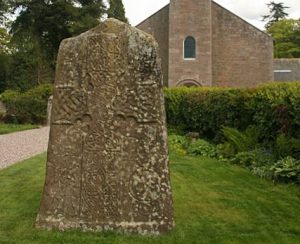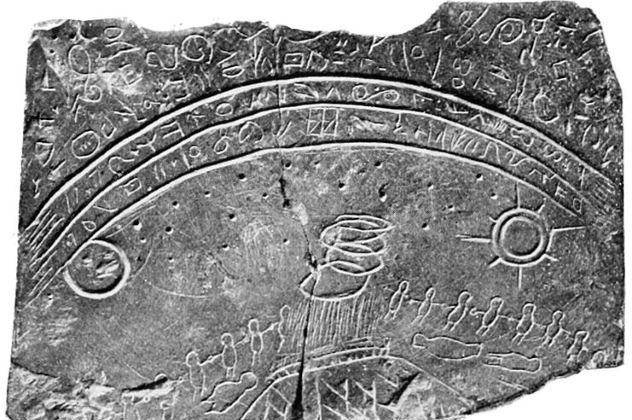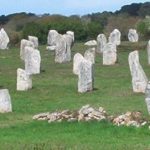 Mysteries
Mysteries  Mysteries
Mysteries  History
History 10 Surprising Stories About the Texas Rangers
 Humans
Humans 10 Philosophers Who Were Driven Mad by Their Own Theories
 Miscellaneous
Miscellaneous 10 Video-Game-Worthy Weapons and Armors from History
 Weird Stuff
Weird Stuff 10 Psychics Who Accurately Predicted Wartime Events
 The Arts
The Arts 10 Pieces of Art Inspired by a Broken Heart
 Health
Health 10 Science Fiction-Sounding New Medical Treatments
 History
History 10 Surprising Facts About the Father of Submarine Warfare
 Space
Space Ten Astonishing New Insights into Alien Worlds
 Weird Stuff
Weird Stuff 10 Bizarre Summer Solstice Rituals Still Practiced Today
 Mysteries
Mysteries Top 10 Haunting Facts About the Ghost Ship MV Alta
 History
History 10 Surprising Stories About the Texas Rangers
 Humans
Humans 10 Philosophers Who Were Driven Mad by Their Own Theories
Who's Behind Listverse?

Jamie Frater
Head Editor
Jamie founded Listverse due to an insatiable desire to share fascinating, obscure, and bizarre facts. He has been a guest speaker on numerous national radio and television stations and is a five time published author.
More About Us Miscellaneous
Miscellaneous 10 Video-Game-Worthy Weapons and Armors from History
 Weird Stuff
Weird Stuff 10 Psychics Who Accurately Predicted Wartime Events
 The Arts
The Arts 10 Pieces of Art Inspired by a Broken Heart
 Health
Health 10 Science Fiction-Sounding New Medical Treatments
 History
History 10 Surprising Facts About the Father of Submarine Warfare
 Space
Space Ten Astonishing New Insights into Alien Worlds
 Weird Stuff
Weird Stuff 10 Bizarre Summer Solstice Rituals Still Practiced Today
10 Hoaxes Carved in Stone
Archaeologists spend their lives searching for great discoveries that will reveal something amazing about the past. Unfortunately, there are people who love to mess with them. Some people create hoaxes for fun, some for profit, and some to bolster their own pet theories about history. Most hoaxes are easy to detect—if a find looks too good to be true, it often is. Many hoaxes are also pretty poorly done. But sometimes, hoaxers go the extra mile.
Here are ten hoaxes that were carved in stone.
Related: 10 Interesting Pseudosciences And Hoaxes
10 Crystal Skulls
In the 19th century, startling finds started coming out of central America that excited both the archaeological and spiritual communities. Skulls carved in intricate detail made from beautiful crystal were snapped up by private collectors and museums alike. While for researchers, they appeared to be the products of a little-known civilization, others thought they had magical properties. These skulls were claimed to be something between mystical healing devices and ancient computers. Could they have been the product of Atlantis or even aliens?
Their first known appearances certainly had a good pedigree. Eugène Boban was the official archaeologist of the Mexican emperor Maximilian I, so he would have had access to ancient sites. Examples of his discoveries ended up in the Musée du Quai Branly in Paris and the British Museum. There were doubts about their origin, however.
Scientific studies of the skulls revealed that the crystal they are carved from is unlikely to have found its way to Mesoamerica. Further examination with electron microscopes showed tell-tale scratches made by modern cutting tools—even identifying them as coming from a German workshop. Whatever Indiana Jones might suggest, they were definitely not the work of interdimensional travelers.[1]
9 Glamis Stone

Scotland is dotted with standing stones that are carved with enigmatic symbols and figures. These Pictish stones often carry fascinating collections of images that some have interpreted as a form of writing—how the symbols are grouped together may suggest a message. No attempts at decipherment have yet been successful, though.
In 1929, however, a stone with a clear writing system was dug up by William Johnston near Glamis. It had four lines of an unmistakably runic alphabet. There was immediate excitement, and an expert on ancient British history was dispatched to examine it. He declared that it was the record of a major battle that had been fought in the area in the 7th century.
Despite this, other experts soon cast doubt on this amazing discovery. The runes were not native to the area and did not carry a message in an old language. Decoding the runes showed they were simply an English message written in the runic alphabet. “Stone cist. Found here. And also to the North.” Who planted this stone is unknown, but they might have left a more exciting Easter egg for people to translate.[2]
8 Kensington Stone
The Norse Sagas of the Greenlanders and Erik the Red from the 13th century describe how Europeans reached the North American continent centuries before Columbus. Most scholars thought these were fanciful stories until evidence of a Norse settlement at L’Anse aux Meadows in Canada were discovered in the 1960s. Some, however, think there is more evidence of Norse contact than some ruins in the ground.
In 1898, a Swedish immigrant named Olof Ohman discovered a large stone with strange markings on it while clearing land in Minnesota. The markings were clearly runic, so they were sent to be translated by experts. The inscription reads:
“We are 8 Goths [Swedes] and 22 Norwegians on an exploration journey from Vinland through the West. We had camp by a lake with 2 skerries one day’s journey north from this stone. We were out and fished one day. After we came home we found 10 of our men red with blood and dead. AVM [Ave Virgo Maria, or Hail, Virgin Mary] save us from evil. We have 10 of our party by the sea to look after our ships, 14 days’ journey from this island. Year 1362.”
This would be incredible proof of Viking journeys deep into America—if most scholars did not think it was a fake. Problems with the language and rune forms all point to it being a hoax. Who carved it? Most point the finger at Ohman himself.[3]
7 AVM Stone

In 2001, more evidence for Norse settlement appeared close to the site where the Kensington Runestone was found. While out examining rocks in the area, Janey Westin, a professional stone carver, happened to glance at a boulder on a small island and noticed that it looked like it had writing on it. She immediately saw it had AVM written on it. This is the same shorthand for “Hail, Virgin Mary” that was found on the Kensington Stone. Later examination also found the date 1363, again linking it to the earlier find.
Unfortunately for those who were certain that this was a major discovery, they were soon disillusioned. A letter sent by two academics admitted that they had carved the stone while they were students. Westin was not happy to have been duped as she had paid to have the stone transported to be kept safe and studied [4]
6 Ica Stones
Outside of The Flintstones or a Creation “museum,” you are unlikely to ever see humans and dinosaurs coexisting. Yet a series of carved stones from Peru seem to show exactly that. Were they lost evidence of modern dinosaurs or proof that the Earth is only a few thousand years old?
The story began in 1966 when Javier Cabrera, a doctor with antiquarian interests, was gifted a stone with what he believed to be an extinct fish engraved on it. He sought out more. After buying several, he was led to the source of these stones—a farmer named Basilio Uschuya, who claimed to have found them in a cave. Soon Cabrera had bought thousands of these stones. They showed remarkable scenes of humans and dinosaurs together and people looking through telescopes and performing complex surgeries.
Cabrera published a book in which he interpreted the facts he found presented on the stones. Humans, he believed, had come to Earth 405 million years ago from another planet. Cabrera abandoned his medical career and opened a museum to display the stones.
Unfortunately for those hoping to meet a dinosaur, the stones were revealed to be hoaxes. Uschuya admitted to creating the stones when he was threatened with prosecution for selling ancient artifacts. They were carved with a dentist’s drill and baked in cow dung to give them the appearance of age.[5]
5 Cardiff Giant
Those who believe in a literal interpretation of the Bible are always keen to find evidence of their faith in the historical record. In 1869, amazing proof was discovered when workers digging a well struck what appeared to be a foot made of stone. Soon they had uncovered a figure 3 meters (10 feet) tall. A tent was thrown over the site, and visitors were charged to come and see the new wonder.
Unlike many hoaxes, however, we know exactly what caused the hoaxer to make his fake. George Hull was a committed atheist and believer in evolution. One day he got into an argument with a Methodist preacher who stubbornly believed all of the Bible was true—even Genesis 6:4, which tells us that a race of giants once roamed Earth. Hull was so enraged by the credulity of people that he set out to fleece them with a petrified “giant” of his own.
People did indeed flock to see this marvel of the ancient world. Hull sold the giant to some investors for $20,000, a huge sum at the time. P. T. Barnum attempted to buy the giant for his circus but was rebuffed. He had his own giant made. When spectators turned up to see this copy of a hoax, one of the original investors is said to have commented, “There’s a sucker born every minute.”[6]
4 Davenport Tablets

There is sometimes an implicitly racist trend in the public discussion of archaeology. Anything interesting created by any civilization other than a European one is seen as a surprise. How could such people have made something so complex? Today, you sometimes hear people claim that aliens must have lent a hand in making everything from pyramids to Easter Island heads. In earlier centuries, however, some thought that anything great from the past must have been made by a lost race of Europeans.
In the 1870s, three tablets were apparently discovered in Native American burial mounds in Iowa that supported this theory. The Davenport tablets show complex illustrations, a calendar, and lines of writing that were supposedly proof that European culture had reached America in ancient times.
However, the tablets had been placed in the burial mounds by a hoaxer. The soil above the tablets had been loosened by whoever planted them there. The tablets had clear indications of modern tool work. It has been suggested that the slates used to make the tablets were taken from a local brothel.[7]
3 Los Lunas Decalogue Stone
What is an archaeologist to do when evidence for their pet theory is lacking in the historical record? Some have found it all too tempting to make their own proof.
In New Mexico, at Los Lunas, you will find a stone that is carved with an old form of Hebrew and a few scattered Greek letters. The stone was first mentioned by archaeologist Frank Hibben who claimed to have seen it in 1933. Hibben was well known for his theories about early contact between Europe and America. This stone would prove that Semitic explorers had reached America a thousand years before Columbus.
One of the problems with the Los Lunas stone is that no one can quite agree on what it says. Is it a version of the Ten Commandments? Or the record of a warrior who got lost? The fact that several of Hibben’s other discoveries have been called into question does not alleviate doubts about the stone.[8]
2 Oklahoma Runestones
Oklahoma is home to one of the most impressive runestones in the world. Most stones marked with runes are in Scandinavia, and few are as large as the Heavener runestone, which stands 3.7 meters (12 feet) tall.
So, were Vikings traipsing around Oklahoma in the 11th century? Not according to experts. The stone found in Heavener would be unusual in many ways. First, there are problems with the runes inscribed on it. Also, the absence of other decoration makes it very different from the runestones of Scandinavia.
But the Heavener stone is not the only runestone in Oklahoma. Others have been found at Poteau and Shawnee. These are also considered to be fakes. They show a mix of runic alphabets that have never otherwise been seen, and the cuts of the runes are hardly weathered at all. Some of the runes appear less weathered than graffiti in the area dating from the 1960s.[9]
1 Beringer Hoax
The most spectacular hoax involving carved stones comes from the 18th century in Germany. Johann Beringer was a famous professor of medicine but had an interest in fossils. Unfortunately, he was also, by all accounts, a very arrogant man. This rubbed some of his colleagues the wrong way, so they decided to have some fun with him.
They decided to have fake fossils carved and placed them in an area Beringer commonly searched for fossils. Some were simple shell shapes that did not look so unusual. But some were highly complex and showed frogs, fish, and even spiders on their webs. Some looked exactly like shooting stars. Beringer was thrilled with his discoveries. He was especially excited to discover some stones that bore the name of God written in Hebrew, Latin, and Arabic. He had found proof that they were placed there by God!
Beringer prepared a costly book to publicize his finds that was richly decorated. Soon, all of Europe would hear about his discoveries. Alas, it was not until after the book was released that Beringer found out about the hoax. His reputation was left in tatters despite his efforts to retrieve all copies of the text. Today the fossils are known as the Lugensteine—the Lying Stones.[10]


